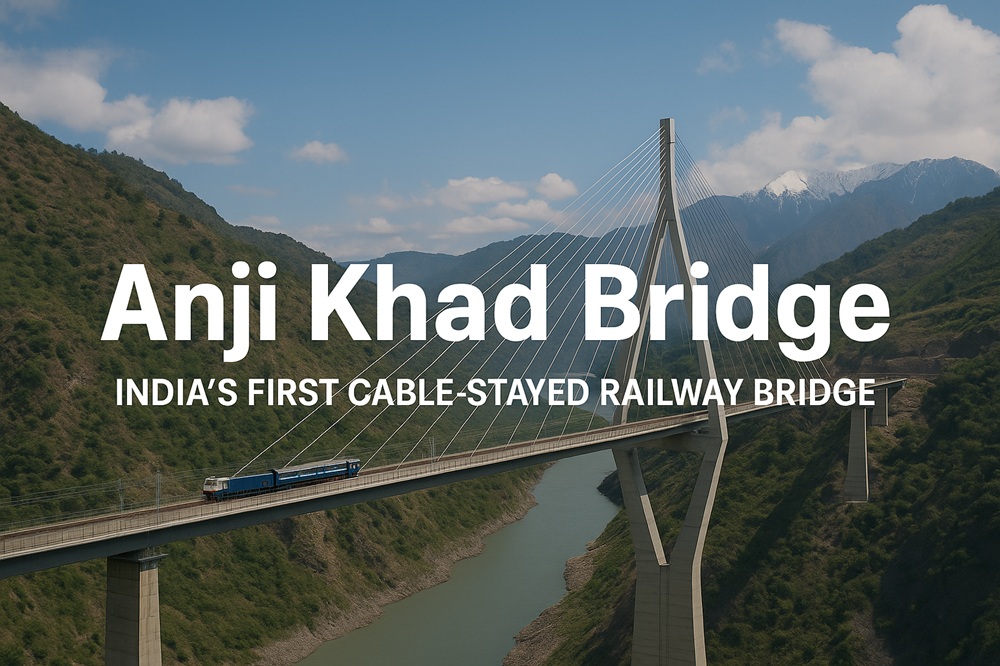In a historic moment for Indian infrastructure and regional connectivity, Prime Minister Narendra Modi inaugurated the Anji Khad Bridge today during his official visit to the Union Territory of Jammu and Kashmir. The bridge, which forms a crucial link in the Udhampur-Srinagar-Baramulla Rail Link (USBRL) project, represents a landmark engineering achievement and a new chapter in economic development for the region.
The inauguration was part of a broader unveiling of transformative infrastructure projects worth over ₹46,000 crore, including the iconic Chenab Rail Bridge, the world’s tallest railway arch. Together, these bridges not only showcase India's engineering prowess but also mark a strategic effort to improve regional integration and boost socio-economic growth in Jammu & Kashmir.
An Engineering Marvel in the Making
The Anji Khad Bridge is India's first cable-stayed railway bridge and spans the deep Anji River gorge between Reasi and Katra districts in Jammu & Kashmir. This high-tech structure is part of the final stretch of the USBRL project, which aims to provide seamless railway connectivity between the Kashmir Valley and the rest of India.
Bridge Type: Cable-stayed railway bridge
Height: Approx. 331 meters above the river bed
Length: 473.25 meters
Main Span: 290 meters
Support: Single Pylon Tower (193 meters tall) anchored by 96 cables
Constructed by: Konkan Railway Corporation Limited (KRCL), under Indian Railways
The Anji Khad Bridge has been designed to withstand extreme weather and seismic conditions. With winds in the Reasi region reaching up to 213 km/h, the bridge was stress-tested with sensors and smart technology to ensure long-term durability.
Strategic and Economic Significance
The Anji Khad Bridge is not just an architectural feat—it is a critical piece of strategic infrastructure. As part of the USBRL project, it connects Kashmir to the rest of the Indian railway network for the first time in history.
Key Benefits:
Boost to Local Economy:
The bridge will provide faster access to markets for local farmers, artisans, and entrepreneurs across Jammu and Kashmir.
Tourism to religious sites like Vaishno Devi and scenic areas such as Pahalgam and Gulmarg will see exponential growth.
Reduced Travel Time & Enhanced Mobility:
The Reasi-Katra-Baramulla railway line significantly reduces travel time for civilians, students, and traders commuting to and from Kashmir.
Strategic Military Access:
The bridge allows quicker and more reliable troop movement, bolstering national security near the northern border with Pakistan and China.
Employment and Development:
The bridge project created thousands of jobs during construction and is expected to spur infrastructure-related employment through ancillary sectors like logistics, warehousing, and tourism.
PM Modi’s Vision for Jammu & Kashmir
Addressing the gathering during the inauguration, Prime Minister Modi stated:
“This bridge is not just steel and concrete—it is a symbol of a new era of trust and transformation in Jammu & Kashmir. We are connecting hearts and homes with highways and railways.”
His visit also included the launch of new Vande Bharat trains, which will operate over these newly connected regions, further enhancing high-speed mobility for the area. PM Modi emphasized his government’s focus on integrating remote regions into the national mainstream through infrastructure, digitalization, and investment.
Local Response: Hope and Opportunity
Locals in Reasi and surrounding districts have hailed the Anji Khad Bridge as a “game-changer.” For decades, remote communities in the mountainous terrain relied on unreliable road routes, often cut off by landslides or snow. The new railway bridge is seen as a vital artery for sustained development.
Ruksana Begum, a school teacher in Katra, said,
“We always hoped that our children would one day be able to commute safely to schools and colleges. Now, it’s not just possible—it’s real.”
Rajeshwar Singh, a fruit trader from Reasi, remarked,
“This bridge means I can now send fresh apples and walnuts directly to Delhi markets without delay.”
International Implications and Engineering Showcase
The Anji Khad Bridge is drawing international attention for its scale and complexity. Infrastructure experts from the EU and U.S. are observing the USBRL project as a case study in extreme terrain connectivity. European cable-stayed bridge models were adapted and modified with indigenous design by Indian engineers, underscoring the country’s growing self-reliance in infrastructure technology.
Looking Ahead
With both the Chenab Bridge and Anji Khad Bridge inaugurated, Indian Railways is now one step closer to completing the USBRL project in full—expected by the end of 2025. This will finally allow uninterrupted rail travel from Kanyakumari to Baramulla, connecting the southernmost and northernmost points of India via a single train network.
As the region opens up to business, tourism, education, and enterprise, the bridges represent more than just connectivity—they are the foundation of a more inclusive, empowered, and integrated India.
🔚 Conclusion
The inauguration of the Anji Khad Bridge is a defining moment for Jammu & Kashmir and for India’s infrastructure ambitions. For local communities, it brings hope and opportunity. For the nation, it marks progress. And for the world, it showcases India's growing capability to deliver under challenging conditions.
